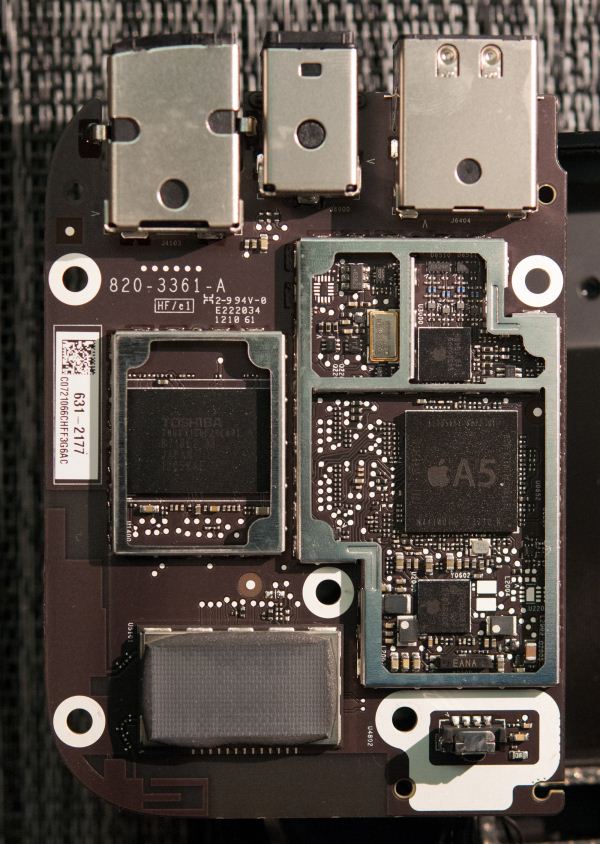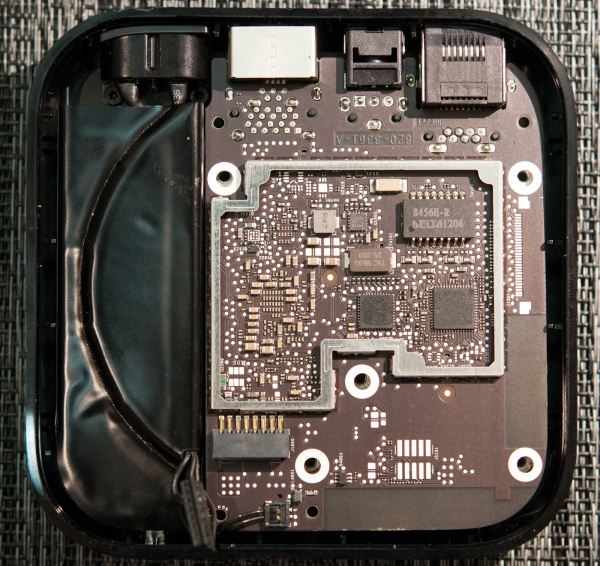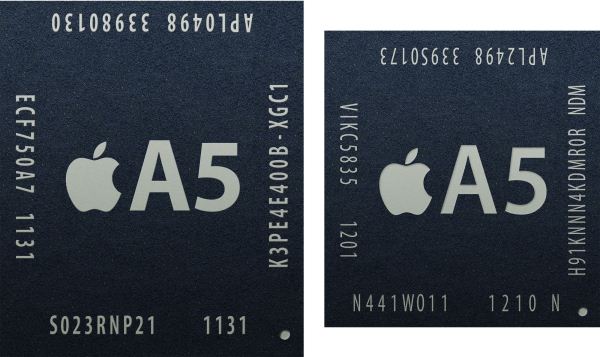Apple TV 3 (2012) Short Review - 1080p and better WiFi
by Brian Klug on March 21, 2012 4:21 PM ESTWhile most of the attention this previous week has been focused on Apple's A5X SoC inside the iPad (3rd Gen), the other Apple-SoC news is that of the S5L8942 or A5 revision 2 inside the Apple TV 3, and iPad2,4. In the case of the Apple TV 3, this A5 consists of a single core ARM Cortex A9, and likely the same PowerVR SGX543 GPU, though Apple hasn't stated how many GPU cores are enabled on this particular variant. We originally speculated that this might be a harvested die with an ARM core or SGX 543 core disabled, and until someone X-rays the package it's hard to know for sure. At this point we also don't know anything about what clocks the A5R2 inside Apple TV 3 is running.
In an attempt to figure this out, I decided to disassemble the Apple TV 3 I purchased to see what's different. Taking the Apple TV 3 apart is the same procedure as the last model. The bottom rubberized plastic cup pops off easily enough with a spudger, then there are some Torx bits securing a metal heatspreader to the PCB. Remove this, disconnect the power supply, and you're basically done. Interestingly enough, nearly every package and EMI can has a thermal pad on top and bottom in the Apple TV 3. I haven't found that the new revision gets warm at all (in fact, just like the previous revision it barely gets warm to the touch), but clearly thermals were a consideration here.
Inside the Apple TV 3 things are arranged the same way as the previous model, with one big PCB sitting next to the power supply. With the EMI cans off, you can see that the second unused NAND pads and area have been removed, and in its place is one Toshiba 8 GB NAND device. To the left of it is the device's WLAN + BT 4.0 combo device, whose EMI cans are soldered on. iFixit has since disassembled an Apple TV 3 as well, and found BCM4330 inside, a choice which isn't surprising at all considering Apple's affinity for Broadcom combo chips. Note that there are two RF chains coming from the device, and two antennas, as opposed to the Apple TV 2's one.
Below that we get the new A5, its PMIC to the left, marked 338S1040-A5, and to the right another Apple-branded package marked 343S0479 which previously was on the other side of the PCB in the Apple TV 2. The markings on top of the A5 (we're looking at the DRAM PoP here, actually) indicate a single Hynix 32-bit 512 MB LPDDR2 device, up from the 256 MB of LPDDR2 in the Apple TV 2.
| A5 Comparisons | |||||||||
| SoC | X | Y | Aspect Ratio (long/short) | Marking | |||||
| A5R1 (S5L8940) | 14.3 mm | 16.7 mm | 1.17 | APL0498 | |||||
| A5R2 (S5L8942) | 13.02 mm | 14.02 mm | 1.07 | APL2498 | |||||
If you've had to stare at the A5 in the iPad 2 or iPhone 4S as much as I have, what should strike you immediately is that its aspect ratio is changed - it's more square than the A5 we've seen before. I measured this package and found that aspect ratio change to be the case. Interestingly enough the A5 in Apple TV 3 is slightly smaller than the iPad 2 / iPhone 4S A5, at 13.02 mm x 14.02 mm. This is as opposed to a package size of 16.7 x 14.3 mm for the A5 we've seen before. Package size alone isn't enough to draw conclusions from about whether this is an entirely new design - it's entirely possible that Apple has simply removed unused pads/balls and repackaged the A5.
One of our readers put together photos of the new A5 based on our package photo (and also put together awesome images of the A4 and A5) for Wikipedia, which really illustrates just how changed the aspect ratio is. I put together a to-scale side by side with the two A5 packages above.
The reverse side of the PCB is less interesting. Here we see the SMSC9730 HSIC USB 2.0 to 10/100 Ethernet controller, Delta Electronics magnetics for the Ethernet jack, and another package whose markings I couldn't make out but seems to have been present on Apple TV 2. There's also the same 30-pin dock port pads in the same place.
Finally, the Apple TV 3 contains the same 3.4V, 1.75A (~6 W) power supply as the previous model. In actual use, I've never seen either the Apple TV 2 or 3 use more than 3 watts while decoding 720p or 1080p video. The corresponding bump in output resolution, SoC, and WLAN stack doesn't seem to have changed power draw at all, or at least not enough that I can measure it on the Kill-A-Watt P4460 which only reports down to 1 watt of precision.



















37 Comments
View All Comments
Teeeee - Wednesday, March 21, 2012 - link
You didn't mention that when Mountain lion is used with AirPlay, that anything you could play on your Mac could be displayed via the apple tv, including previous downloaded shows and stuff in additional file formats or websites.Brian Klug - Thursday, March 22, 2012 - link
I've updated with a clearer mention. Admittedly I haven't gotten around to trying Mountain Lion out, however.-Brian
relentlessfocus - Wednesday, March 21, 2012 - link
I personally feel that Apple's strategy is to make the iPad and possibly the iPhone the real source for content with the AppleTV being only an iOS tv accessory. With 100 million iPads sometime in 2012 and a few hundred million iPhones its a nice accessory to have.Hulu I believe is on the iPad in the US, certainly here in the UK its possible to mirror the BBC's iPlayer to the AppleTV even though there isn't an AppleTV iPlayer app (yet). Bloomberg TV Airplays nicely to the AppleTV and Sky and other channels here in the UK are on the iPad. Given the complexity of digital rights its far easier for Apple to let the copyright owners make their own apps for the iPad than it is to work out deals with Apple as middleman via iTunes.
Fanfoot - Tuesday, March 27, 2012 - link
Well, sort of.On iOS Apple has allowed app developers to block mirroring to the Apple TV. For example, HBO Go and Hulu both do NOT allow mirroring on the iPad. So for the moment, an Apple TV isn't as good a TV streamer device as some others if you judge it simply on its abilities to play back HBO Go or Hulu Plus or whatever.
With Mountain Lion Apple seems to be taking a different stance, simply encoding whatever is on the display and since most viewing is done inside a browser, it isn't clear how/if any site will be able to block mirroring from working. Right now the working assumption is that sites like the free Hulu WILL work on Mountain Lion. Which may help to push things forward and stop this sort of behavior on iOS devices going forward.
ltcommanderdata - Wednesday, March 21, 2012 - link
"While most of the attention this previous week has been focused on Apple's A5X SoC inside the iPad (3rd Gen), the other Apple-SoC news is that of the S5L8942 or A5 revision 2 inside the Apple TV 3, and iPad2,4."In page 2 of the article you mention the iPad2,4? Where does this come from? Are you saying Apple quietly revved the iPad 2 when they dropped the price to $399? Hopefully not. With 1x512MB on a 1x32-bit memory bus in the new A5 versus 2x256MB on a 2x32-bit memory bus in the old A5, that would fragment the iPad 2 userbase with different performance profiles.
Brian Klug - Thursday, March 22, 2012 - link
The iPad2,4 reference comes from numerous configuration files/plist files in iOS 5.1. At this point I don't know if it's simply the iPad 2 R2 (aka cheapified iPad 2) or something else, and I think the jury is still out. Even so it's possible to just put a different memory device on top and maintain 2x32 (which I hope they've done) whereas the ATV3 just gets the 1x32 512 MB device.Again, I haven't seen that iPad out in the wild, but it definitely includes the same Apple SoC revision.
-Brian
ltcommanderdata - Thursday, March 22, 2012 - link
Maybe it's the much speculated iPad Mini? Personally, given Apple's talk of iPads in education and the learning potential that is there for students, I'm hoping it's a cut down education specific iPad 2 model. A single core A5 should be sufficient for iBook textbooks and learning games and selling it with dramatically reduced profit margin at say a $249 unit price would really drive school adoption. It won't be an immediate money maker for Apple, but early iOS familiarity can ripple into continued iOS customers as the kids grow up. All pure speculation of course.Morelian - Wednesday, March 21, 2012 - link
I've owned the Apple TV (2) for the past year or so and have found it a useful device. We have multiple Iphones and Ipads in the house so the airplay thingy is good, and the apple tv will get media off the windows pcs as well. In my house it is mostly used as the Netflix access device hooked up to the 52 inch hdtv. The Netflix app on the Apple TV is better than the one on the Sony Blueray player.The selling point to me is if you have other Apple products the device is handy but even if you don't, it still is a good buy if your TV doesn't have a Netflix player attached.
This review tells me I should get new Apple TV for the big TV and give the kids who have the little TV the old one :P
amagrude - Wednesday, March 21, 2012 - link
The remote is slightly different in the Apple TV v3. The top 4-way circle has a pronounced circle bulge along the inner circle. The v2 remote (and every other metal one I've used) was rounded smooth in the shape of the contour of the remote. I like the new feel better - easier to get your finger into the center of that 4-way switch w/o looking.Brian Klug - Thursday, March 22, 2012 - link
Weird, I bought my Apple TV 2 about halfway into its product cycle, so I think I might've just gotten the updated remote.Compare if you will the Apple TV 2 and 3 remote (the 2 is the one with small dents/scuffs from where I've dropped it) in the gallery: http://www.anandtech.com/Gallery/Album/1822#13
http://www.anandtech.com/Gallery/Album/1822#12
-Brian